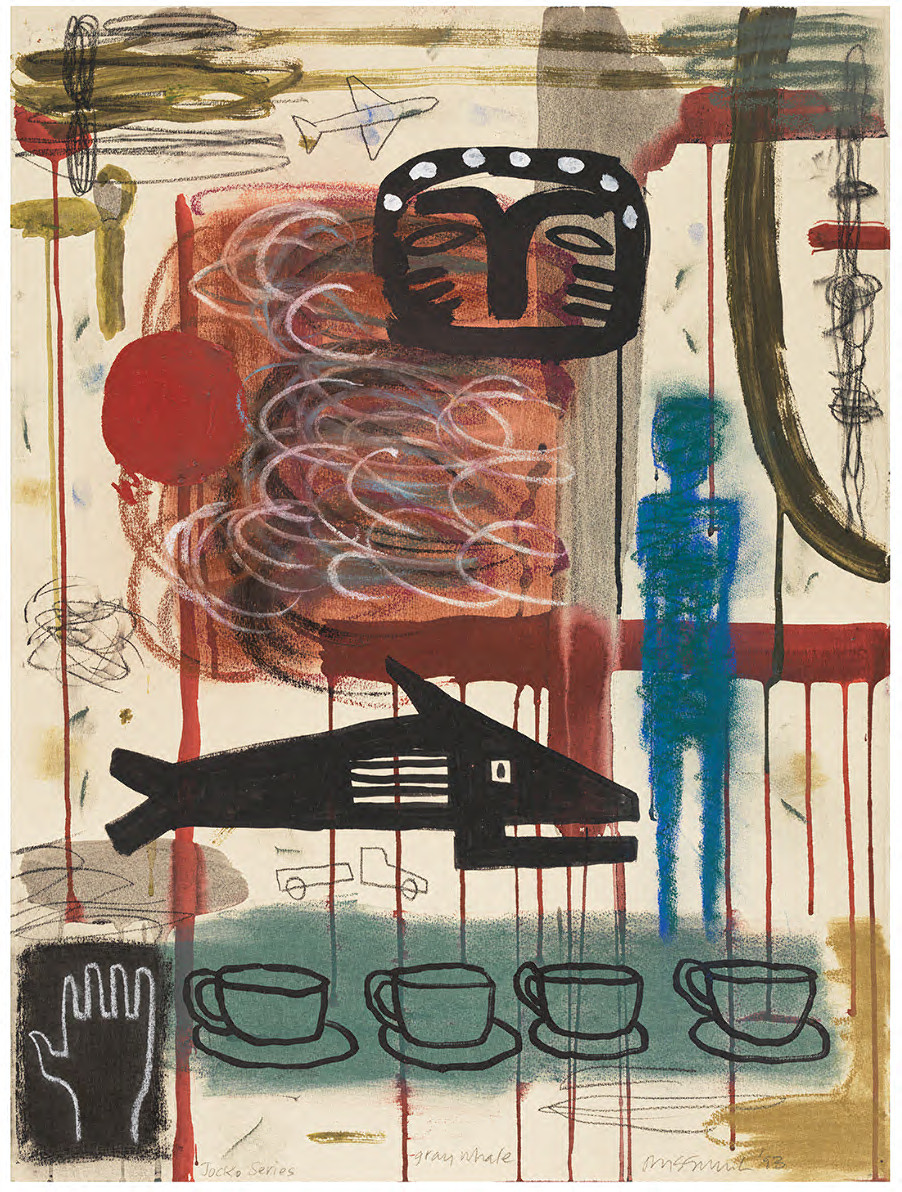Object of the Month: 'Jocko, Gray Whale' (1993) by Jaune Quick-To-See Smith
By Bowdoin College Museum of ArtThe recent acquisition of a drawing by Jaune Quick-To-See Smith marks the first of the artist’s work to be represented in the BCMA’s Permanent Collection.

Jaune Quick-To-See Smith, Jocko, Gray Whale, 1993, acrylic, pastel, and charcoal on paper, 30 x 22 inches. Bowdoin College Museum of Art, Brunswick, Maine. Museum Purchase with Funds Contributed by Jimmy Ellis ’82, Martha Henry ’82, and Leslie Rainer ’82 in memory of Yvonne Swann Simon ’82. © Estate of Jaune Quick-to-See Smith
The Museum is proud to announce the acquisition of an important drawing by Jaune Quick-To-See Smith, who passed away at age 85 on January 24, 2025. Three friends in the Class of 1982— Jimmy Ellis, Martha Henry, and Leslie Rainer—provided the funding that allowed the BCMA to purchase this drawing. They made this gift in memory of their classmate Yvonne Swann Simon (1960-2023).
Born at the St. Ignatius Indian Mission on the Flathead Indian Reservation in central Montana, Jaune Quick-To-See Smith was an enrolled Salish member of the Confederated Salish and Kootenai Nation, Montana. Smith was one of the most acclaimed Native American artists of her generation, having had over 100 solo exhibitions in the past forty years. Over that same time, she organized and/or curated over thirty exhibitions of Native American art and lectured at more than 200 universities, museums and conferences internationally, most recently at five universities in China. Smith completed several collaborative public art works, including the floor design in the Great Hall at the Denver Airport; an in-situ sculpture piece in Yerba Buena Park, San Francisco; a mile-long sidewalk history trail in West Seattle; and a new terrazzo floor design at the Denver Airport. Among her many awards are a Joan Mitchell Foundation Painters Grant in 1996; the Women’s Caucus for the Arts Lifetime Achievement Award in 1997; the College Art Association Women’s Award in 2002; a Visionary Woman Award in 2011, and four honorary doctorates. Her work has been collected by museums throughout the United States and beyond.
This drawing comes from Smith’s series entitled Jocko, which she undertook in the 1990s. Visually, Gray Whale exemplifies the aesthetics for which Smith is known. The drawing is executed in acrylic paint, pastel, and charcoal to create a layered composition that recalls Smith’s work in painting, printmaking, and multimedia collage. Over the cream background, Smith layers a series of representational images that reference modern life, including a soaring airplane, large truck, and a line of teacups. Other tribal motifs reference Smith’s Native American heritage, perhaps most prominently the large whale at the center of the drawing. With this element, Smith uses negative space to create details on the whale’s body and face, recalling the formline designs of the Pacific Northwest Coast tribes, including the Salish. The bold, gestural washes of color and paint drips evoke the work of abstract expressionists who have influenced Smith’s work, including Robert Rauschenberg, Joan Mitchell, and Jasper Johns.
The title of the drawing, and the series of which it is a part, references the Jocko River that flows through the Flathead Indian Reservation, where Smith was born and raised. Smith’s attention to place aligns with what was, at the time, an emerging interest in critically engaging with the map and Western cartographic traditions. Her focus on place and landscape also reflects Smith’s career-long commitment to commenting on issues of environmentalism in her work from an Indigenous worldview.
Smith was arguably one of the most important contemporary Indigenous artists of her day. Her work has been central to (re)defining contemporary Native American art, while her role as an educator, curator, and activist has had substantial impacts on the ways in which Indigenous art has been understood and appreciated in the twentieth and twenty-first centuries. The Museum is thrilled to add this important work to its collection and expresses its gratitude to the three Bowdoin classmates who made possible its acquisition.